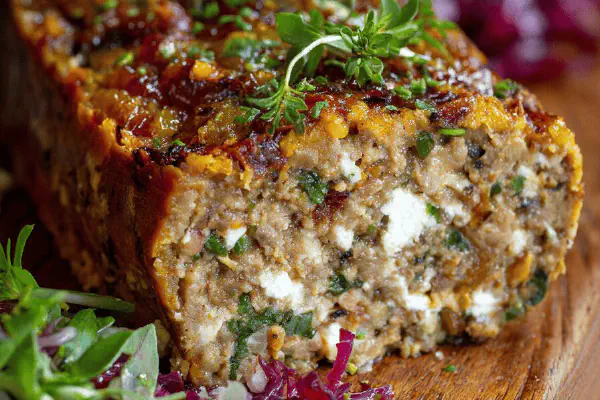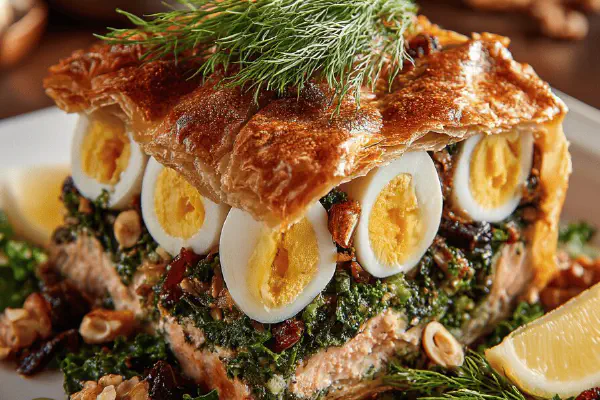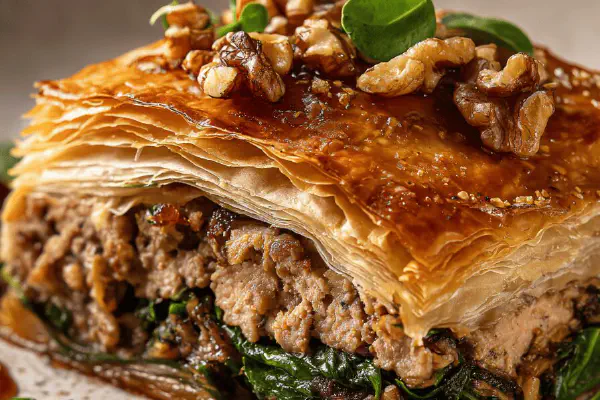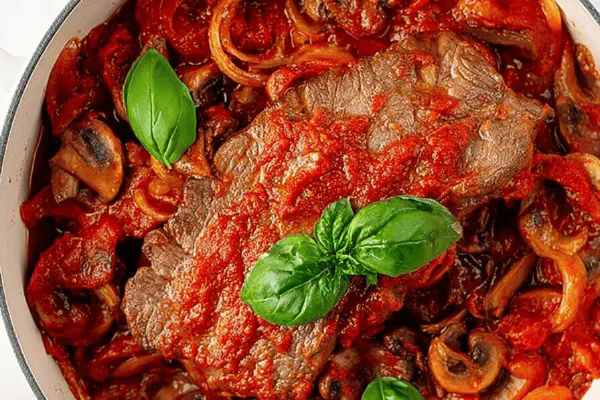Rustic Meat Pâté

By Emma
Certified Culinary Professional
Ingredients
Filling
- 1 medium celeriac, peeled and diced small
- 3 tbsp olive oil, divided
- 1 medium onion, finely chopped
- 400 g lean ground pork
- 1 cup chicken broth
- 2 tbsp fresh breadcrumbs
- 1/4 tsp ground cinnamon
- 1/4 tsp ground allspice
- 1/4 cup dried apricots, chopped (substitute dates)
Crust
- 2 cups all-purpose flour
- 1/2 tsp fine salt
- 3/4 cup cold unsalted butter, cubed
- 1/2 cup ice water, plus more as needed
- Milk, for brushing
Garnish
- 1 stalk celery, finely diced
- 1 tbsp lemon juice
- 1 tbsp olive oil
- 1/4 cup chopped fresh cilantro (replace parsley)
About the ingredients
Method
Filling
- Set rack mid-oven; preheat to 205°C (400°F). Toss celeriac with 2 tbsp olive oil; season with salt and pepper. Roast on parchment-lined tray until fork-tender, about 23 minutes; watch for a little caramel in corners. Let cool.
- Meanwhile, heat remaining olive oil in a hot skillet. Sweat onion till translucent, edges turning golden—aroma should build. Add pork, crumble as it browns but don’t overcook, leaving it slightly pink inside to keep moisture. Pour in broth. Stir in breadcrumbs, cinnamon, and allspice. Continue cooking on high, stirring often until liquid nearly evaporates and mixture feels thick and sticky—about 9 minutes. Salt and pepper well. Let cool completely.
Crust
- Pulse flour and salt together in food processor. Drop cold butter cubes in; blitz intermittently. You want pea-sized lumps, not a paste. Slowly add ice water while pulsing; stop as soon as dough just clumps together. If too crumbly, add water dropwise—too wet, tough crust. Turn dough out, form tight disk, wrap in plastic. Chill 25 minutes minimum for rest and butter to firm up.
Assembly
- Flour work surface lightly. Roll dough to about 35 cm (14 inches) diameter; rough circle is fine. Transfer carefully to parchment-lined sheet.
- Spread pork filling unevenly but staying 5 cm (2 inches) from edge. Scatter chopped apricots over meat. Spoon roasted celeriac over apricots to finish layering.
- Fold edges inward to make loose, messy pleats, leaving small hole exposed in center for steam. Don’t seal it airtight—that crust needs to breathe and brown. Too tight, pastry gets soggy underneath.
- Brush entire pastry with cold milk for that golden sheen. Pop into oven and bake about 33 minutes. Crust will hiss faintly as butter melts, edges should turn rich golden-brown, cracks and crispness visible. Bottom should slide slightly on tray when done.
Garnish
- Combine diced celery, lemon juice, olive oil, and cilantro in bowl. Season with salt and pepper. Scatter fresh herb salad atop the pâté right after removing from oven for a fresh, tangy crunch contrast.
Cooking tips
Chef's notes
- 💡 Roast celeriac till fork-tender but watch for dark caramel spots. Those little corners tell you roast done. Don’t go mushy or watery or whole flavor drops. Cool fully before layering. Roast time varies with size; smaller cubes cook faster.
- 💡 Handle butter cold, cut into peas not a paste. Work quick with ice water pulse only enough to clump dough. Over-pulse and you get mush, no flake. Dough rest in fridge is non-negotiable for flaky edges. Wrap tight or butter absorbs fridge odors.
- 💡 When sweating onions, wait for edges to golden, smell deep caramel notes. Then add pork; keep heat high, brown not steam. Stir meat to crumble, color buildup adds flavor but stop short of dry. Pour broth trick helps keep moist inside.
- 💡 Filling needs thick consistency: cook down broth till sticky, no soup. Breadcrumbs bind moisture but use fresh or stale - old crunchy store crumbs dry. Spices cinnamon and allspice subtle, add depth not heat. Dried apricots bring chew and brightness, subs vary texture & sweetness.
- 💡 Folding crust edges uneven leaves rustic charm. Leave center hole for steam vent, avoid soggy base. Brush milk cold and thin to give sheen without puddles. Baking sound is subtle hiss then crackle; smell butter to judge doneness. Remove from sheet immediately when ready.
Common questions
Can I substitute pork?
Yes, turkey or chicken can swap in but adjust fat. Leaner meats dry faster, add bit more broth or butter in crust to compensate. Flavor shifts but texture manageable. Mixing meats works too.
What if dough cracks while rolling?
Chill more, let rest longer. Use minimal flour on surface. Too cold and brittle, warm a little before rolling. Patch tears with small dough pieces pressed gently. Flaky repairs hold bake fine.
How to avoid soggy bottom crust?
Vent center hole crucial for steam escape. Don’t seal edges tight. Preheat oven fully so bottom starts cooking immediately. Consider placing baking sheet low in oven. Don’t overload wet filling, thick helps freshness.
Storing leftovers?
Refrigerate airtight up to three days. Reheat slowly to keep crust crisp; oven or pan good, microwave makes pastry soggy fast. Freezing whole pie tricky; freeze filling separately if needed. Defrost fully before reheating.



